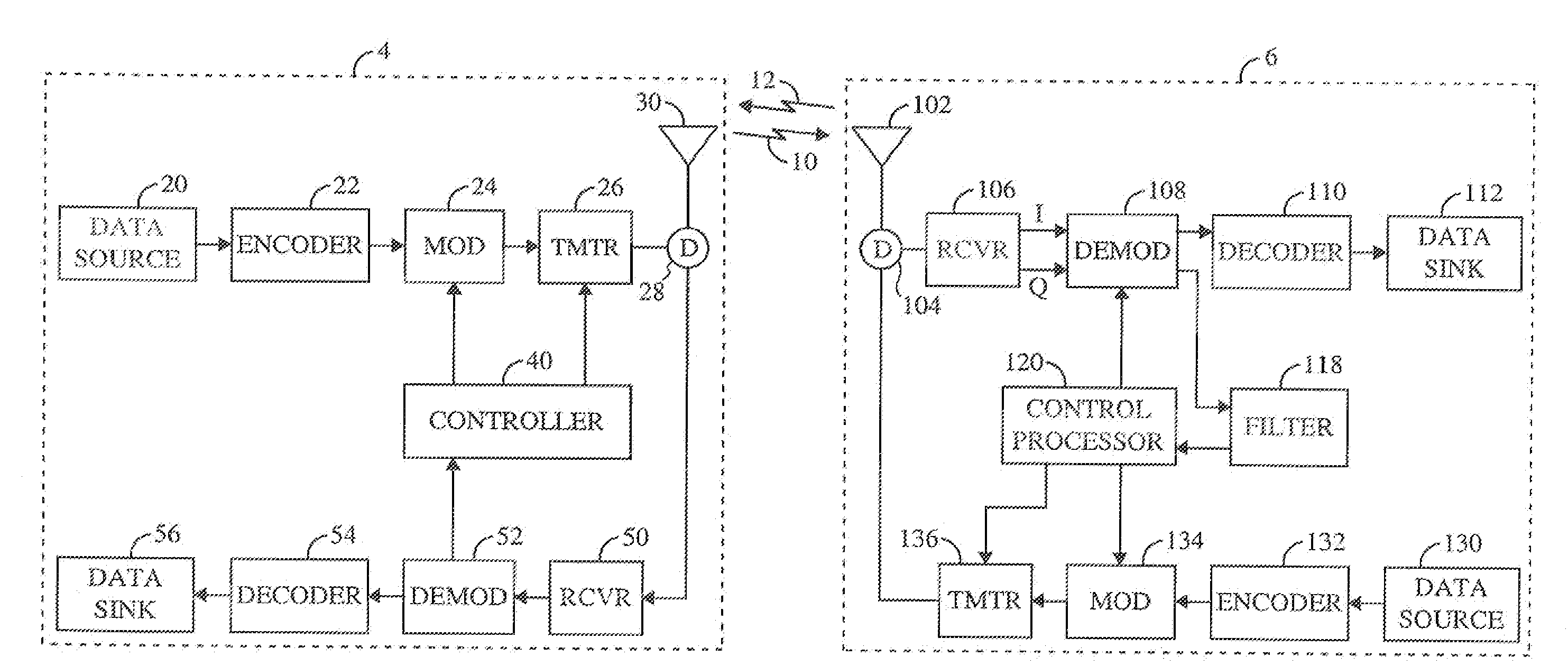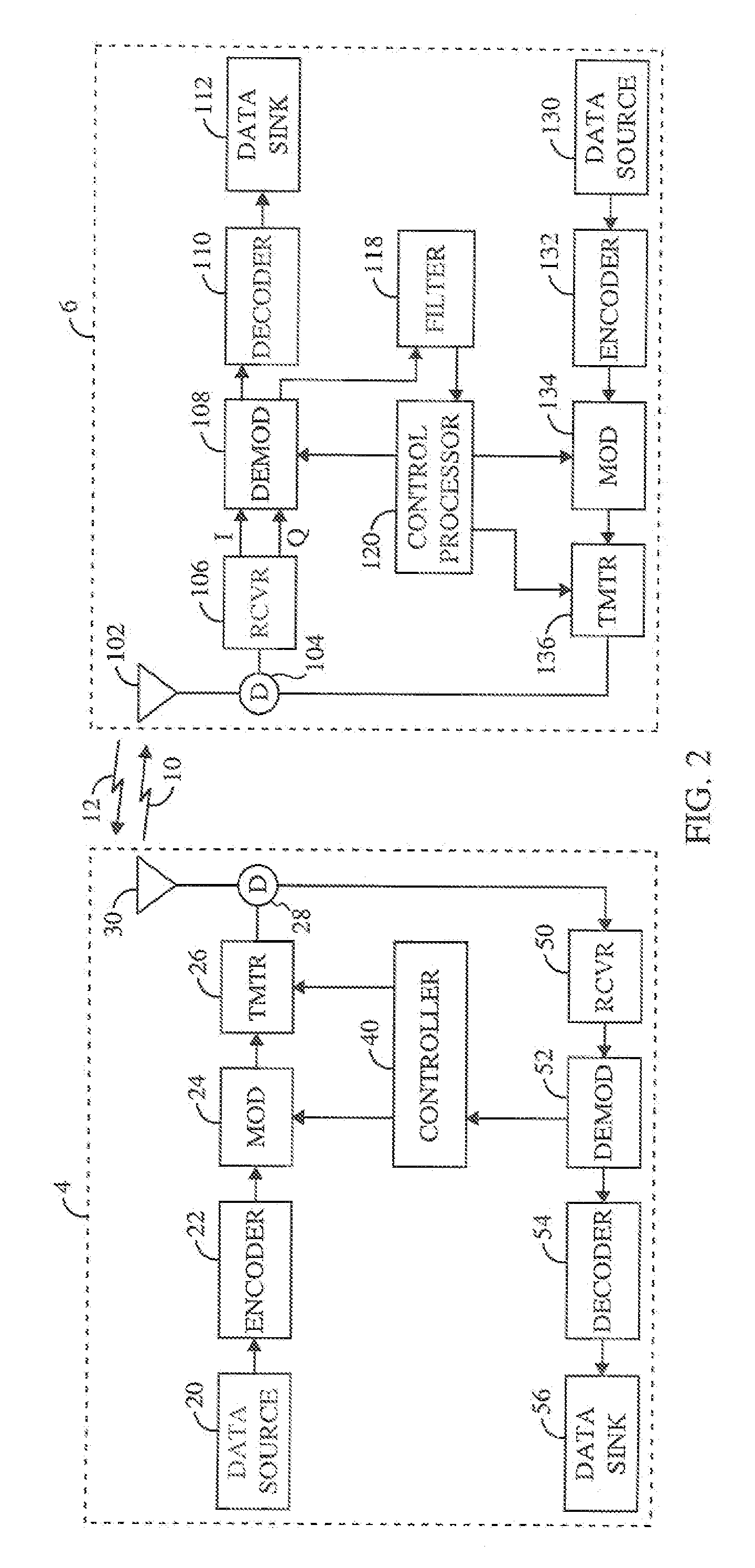Method and apparatus for forward link power control
a forward link and power control technology, applied in power management, wireless communication, pulse technique, etc., can solve the problems of excessive interference with the received signals, remote stations can receive erroneous data transmissions, and limited reverse link capacity, so as to improve the response time of the forward link power control loop, the effect of minimizing interference to other base stations and high-rate forward link power control
- Summary
- Abstract
- Description
- Claims
- Application Information
AI Technical Summary
Benefits of technology
Problems solved by technology
Method used
Image
Examples
first embodiment
[0066]In the first embodiment, threshold adjust circuit 200 updates the value of z according to the equation:
zk={zk-1+γek-1=1zk-1-δek-1=0,(3)
where zk is the target energy level at the kth frame, ek−1 is the frame error at the (k−1)th frame, γ is the size of an upward step to be applied to the target energy level, and δ is a size of a downward to be applied to the target energy level. In the exemplary embodiment, ek−1 is set equal to 1 if there was a frame error for the (k−1)th data frame and 0 otherwise. The values for γ and δ are selected to provide a desired level for the FER. Typically, γ is large and δ is small. This selection creates a sawtooth-like pattern for zk. When a frame error occurs, zk increases substantially to minimize the probability of another frame error. When there is no frame error, zk slowly decays to minimize the transmission power. In the exemplary embodiment, the values for zk, γ and δ are in dB scale, although a linear scale for these variables can also be ...
second embodiment
[0067]In the second embodiment, the stepsizes γ and δ can be made functions of the current target energy level zk−1 so that the correction to zk is dependent on the current target energy level. Thus, equation (3) can be modified as
zk={zk-1+γ(zk-1)ek-1=1zk-1-δ(zk-1)ek-1=0.(4)
[0068]In the exemplary embodiment, remote station 6 completes demodulation of the data frame and updates the target energy level zk during the middle of the succeeding frame. If the (k−1)th data frame is received in error, the probability of a frame error for the kth data frame is greater. This is because any adjustment to the target energy level will not have an immediate impact on the FER performance until the system has had sufficient time to make a transition to the new operating point. Therefore, the second of two consecutive frame errors should not be interpreted as indicative of the performance of the target energy level value which was just updated as a result of the first frame error.
[0069]In the preferr...
third embodiment
[0079]In a third embodiment, shown in the bottom diagram of FIG. 7, the forward link power control bit is transmitted as a short pulse of approximately 0.41 msec in duration at a predetermined amount of time (“delay2” in FIG. 7) after reception of the reverse link power control bit on the forward traffic channel. The duration of the forward link power control bit is chosen to be small enough so that it will be finished by the time the following forward link power control bit is to be sent, even in the worst case when the latest possible time slot is used in the current power control group and the earliest possible time slot is to be used in the following power control group. In the exemplary embodiment, the amount of delay is set to 0.050 msec (delay2=0.050 msec). As illustrated in FIG. 7, this embodiment entails higher transmission power for the duration of the pulse in order to transmit the same amount of energy over a shorter pulse duration. One drawback of this method is that th...
PUM
| Property | Measurement | Unit |
|---|---|---|
| length | aaaaa | aaaaa |
| time | aaaaa | aaaaa |
| transmit power | aaaaa | aaaaa |
Abstract
Description
Claims
Application Information
 Login to View More
Login to View More - R&D
- Intellectual Property
- Life Sciences
- Materials
- Tech Scout
- Unparalleled Data Quality
- Higher Quality Content
- 60% Fewer Hallucinations
Browse by: Latest US Patents, China's latest patents, Technical Efficacy Thesaurus, Application Domain, Technology Topic, Popular Technical Reports.
© 2025 PatSnap. All rights reserved.Legal|Privacy policy|Modern Slavery Act Transparency Statement|Sitemap|About US| Contact US: help@patsnap.com



